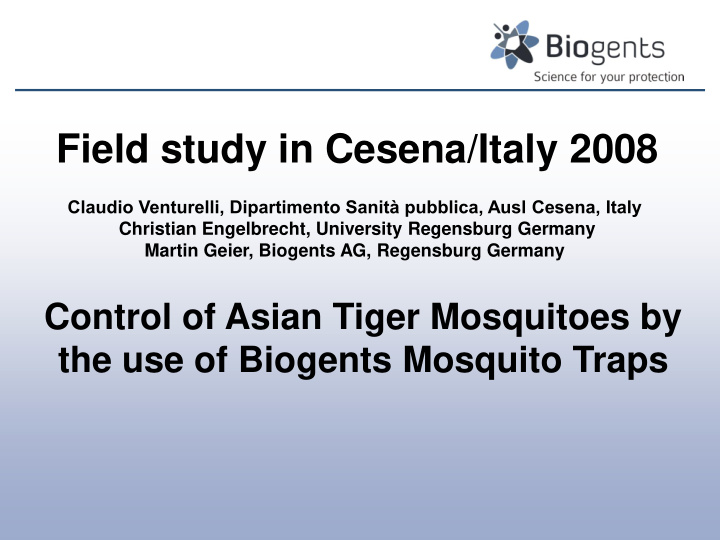



Field study in Cesena/Italy 2008 Claudio Venturelli, Dipartimento Sanità pubblica, Ausl Cesena, Italy Christian Engelbrecht, University Regensburg Germany Martin Geier, Biogents AG, Regensburg Germany Control of Asian Tiger Mosquitoes by the use of Biogents Mosquito Traps
Location: Cesena/Italy, city with 100.000 people Time: June to October 2008 Study design: Selection of 6 areas in Cesena where Asian Tiger mosquitoes (Aedes albopictus) occur. (Based on ovitrap measurements of the last years) 3 areas are randomly allocated to receive the treatment with traps, the other 3 areas are control areas where no traps are placed. The treatment sector receives 8 traps, placed outdoor, run constantly for 24h, from June to October. The control sector has no traps. Following parameters are measured in all sectors: - Human landing rates (same person, 1h in the afternoon, every 5-7 days) - 2 Ovitraps are placed in a sector, weekly collections
Intervention and control areas Six areas with simlar environmental conditions have been selected - Three intervention areas with placement of traps: red dots - Three control areas without placement of traps: blue dots
Area 1: Treatment with traps 40m x 45m = 1800sqm 25 m Biogents traps Ovitraps (for monitoring deposited eggs) Position, where human landing rates are measured M
Area 2: Treatment with traps 60m x 50m = 3000 sqm 20 m Biogents traps Ovitraps (for monitoring deposited eggs) Position, where human landing rates are measured M
Area 3: Treatment with traps 113m x 55m = 6215 sqm M 20 m Biogents traps Ovitraps (for monitoring deposited eggs) Position, where human landing rates are measured M
Area 4: Control 30 m Ovitraps (for monitoring deposited eggs) Position, where human landing rates are measured M
Area 5: Control 30 m Ovitraps (for monitoring deposited eggs) Position, where human landing rates are measured M
Area 6: Control 30 m Ovitraps (for monitoring deposited eggs) Position, where human landing rates are measured M
Summary of all three areas: Reduction of human landing rates Mean human landings per hour 45 40 35 30 25 20 15 No traps 10 5 With traps 0 20 25 30 35 40 45 May June July August September October
Summary of all three areas: Reduction of egg production 1200 Number of eggs in ovitraps 1000 800 With traps 600 No traps 400 200 0 28 33 38 43 Week
Summary From 1 August to 30 Areas with Areas without Reduction in % September traps traps Total human landing 81 759 89,3 counts Total number of 1612 4950 67,4 colleceted eggs in ovitraps
Recommend
More recommend